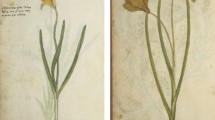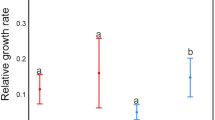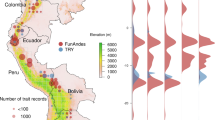Abstract
THE aggressiveness of Indian populations of Xanthium suggested exotic niche capacities of introduced plants. To test this hypothesis, the plants were compared with Xanthium from America and from Hong Kong. Effects of photoperiod and temperature conditions were tested and the plants examined chemically. The treatment of Xanthium, based largely on burrmorphology, is various. The indigenous populations of Europe and Asia are referred to X. strumarium L. and closely related species1,2 or to the strumarium morphological complex3. The indigenous American populations have been referred to numerous species1,2 and to seven morphological complexes3. Populations of the southeastern US and the Caribbean islands have been referred to the chinense morphological complex3.
This is a preview of subscription content, access via your institution
Access options
Subscribe to this journal
Receive 51 print issues and online access
$199.00 per year
only $3.90 per issue
Buy this article
- Purchase on Springer Link
- Instant access to full article PDF
Prices may be subject to local taxes which are calculated during checkout
Similar content being viewed by others
References
Widder, F. J., in Fedde: Repert. Spec. Nov. Regn. Veget., 20 (Berlin, 1923).
Millspaugh, C. F., and Sherff, E. E., Field Mus. Nat. Hist. Publ., 204, Bot. Ser., 4, 9 (1919).
Löve, D., and Dansereau, P., Can. J. Bot., 37, 173 (1959).
Ray, P. M., and Alexander, W. E., Amer. J. Bot., 53, 806 (1966).
McMillan, C., Science, 165, 292 (1969).
McMillan, C., Amer. J. Bot., 57, 881 (1970).
McMillan, C., Science, 171, 1029 (1971).
McMillan, C., Amer. J. Bot. (in the press).
McMillan, C., Can. J. Bot. (in the press).
Kaul, V., New Phytol., 70, 799 (1971).
Brewbaker, J. L., Upadhya, M. D., Makinen, Y., and MacDonald, T., Physiol. Plant., 21, 930 (1968).
Mabry, T., in Phytochemical Phytogeny (edit. by Harborne, J. B.) (Academic Press, London, 1970).
Minato, H., and Horibe, I., J. Chem. Soc., 7009 (1965).
Geissman, T. A., Deuel, P., Bonde, E. K., and Addicott, F. A., J. Amer. Chem. Soc., 76, 685 (1954).
Everist, S. L., Queensl. Natur., 16, 49 (1960).
Author information
Authors and Affiliations
Rights and permissions
About this article
Cite this article
MCMILLAN, C. Photoperiod and Chemical Evidence of the Introduction to India of Xanthium from America. Nature 240, 485–486 (1972). https://doi.org/10.1038/240485a0
Received:
Revised:
Issue Date:
DOI: https://doi.org/10.1038/240485a0
This article is cited by
-
Photoperiodic responses in experimental hybrids of cockleburs
Nature (1974)
-
Photoperiodic responses ofXanthium strumarium L. (Compositae) introduced and indigenous in eastern asia
The Botanical Magazine Tokyo (1974)
-
Partial Fertility of Artificial Hybrids between Asiatic and American Cockleburs (Xanthium strumarium L.)
Nature New Biology (1973)
Comments
By submitting a comment you agree to abide by our Terms and Community Guidelines. If you find something abusive or that does not comply with our terms or guidelines please flag it as inappropriate.



